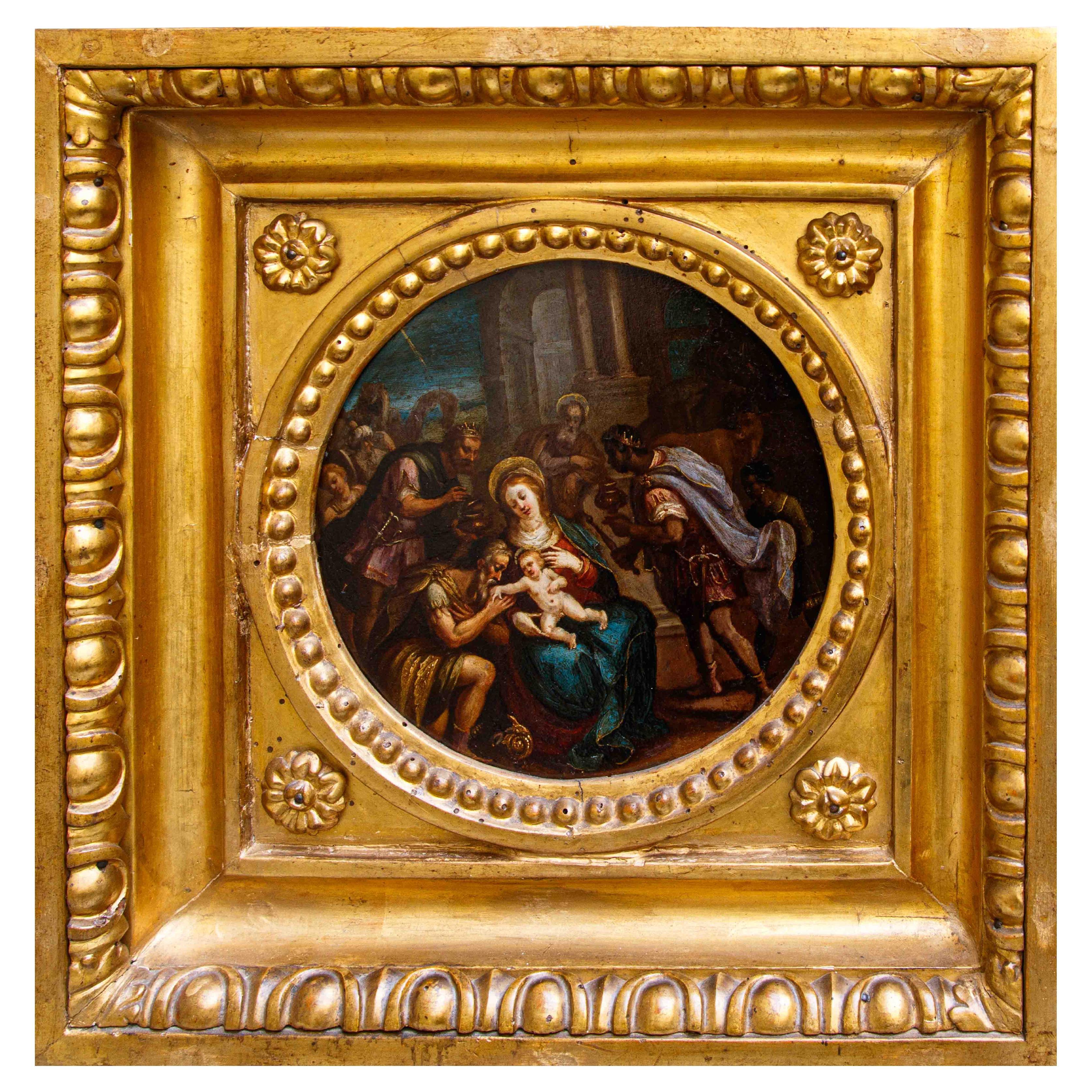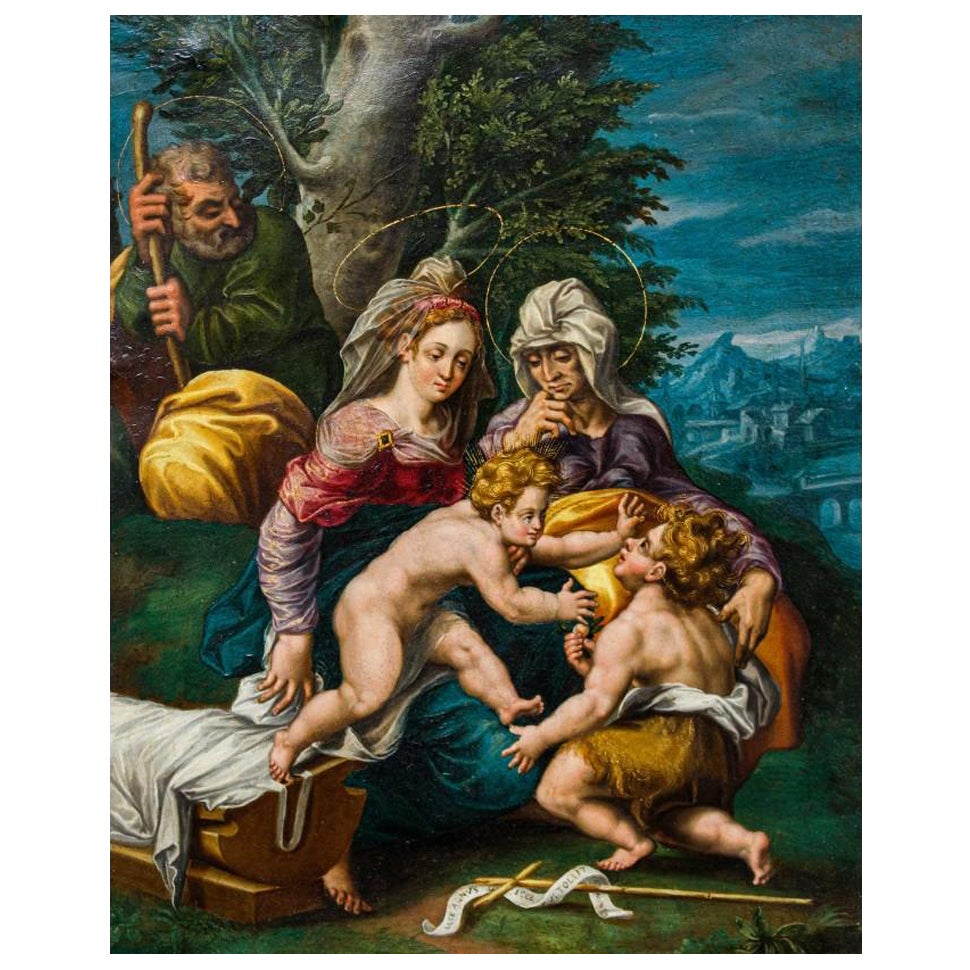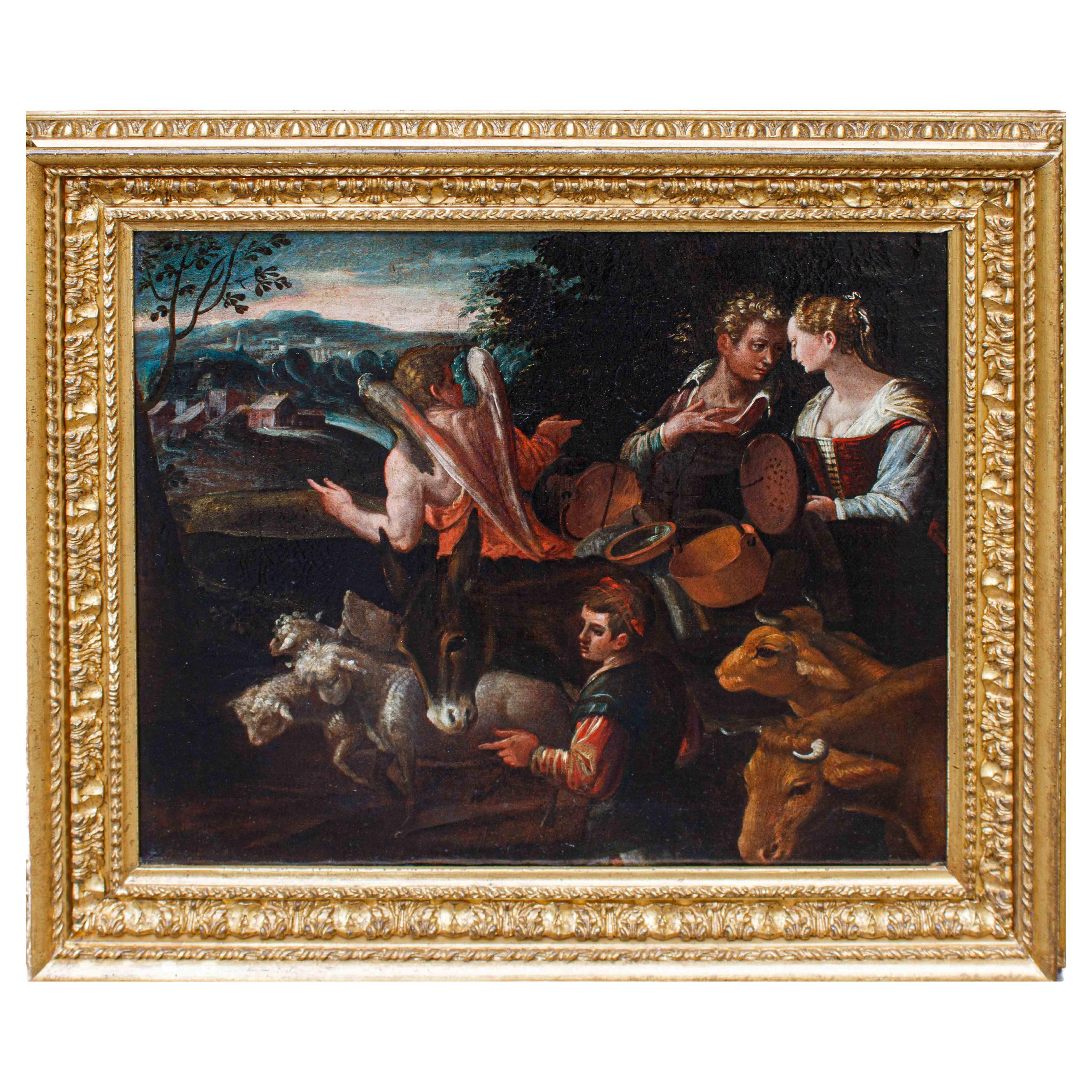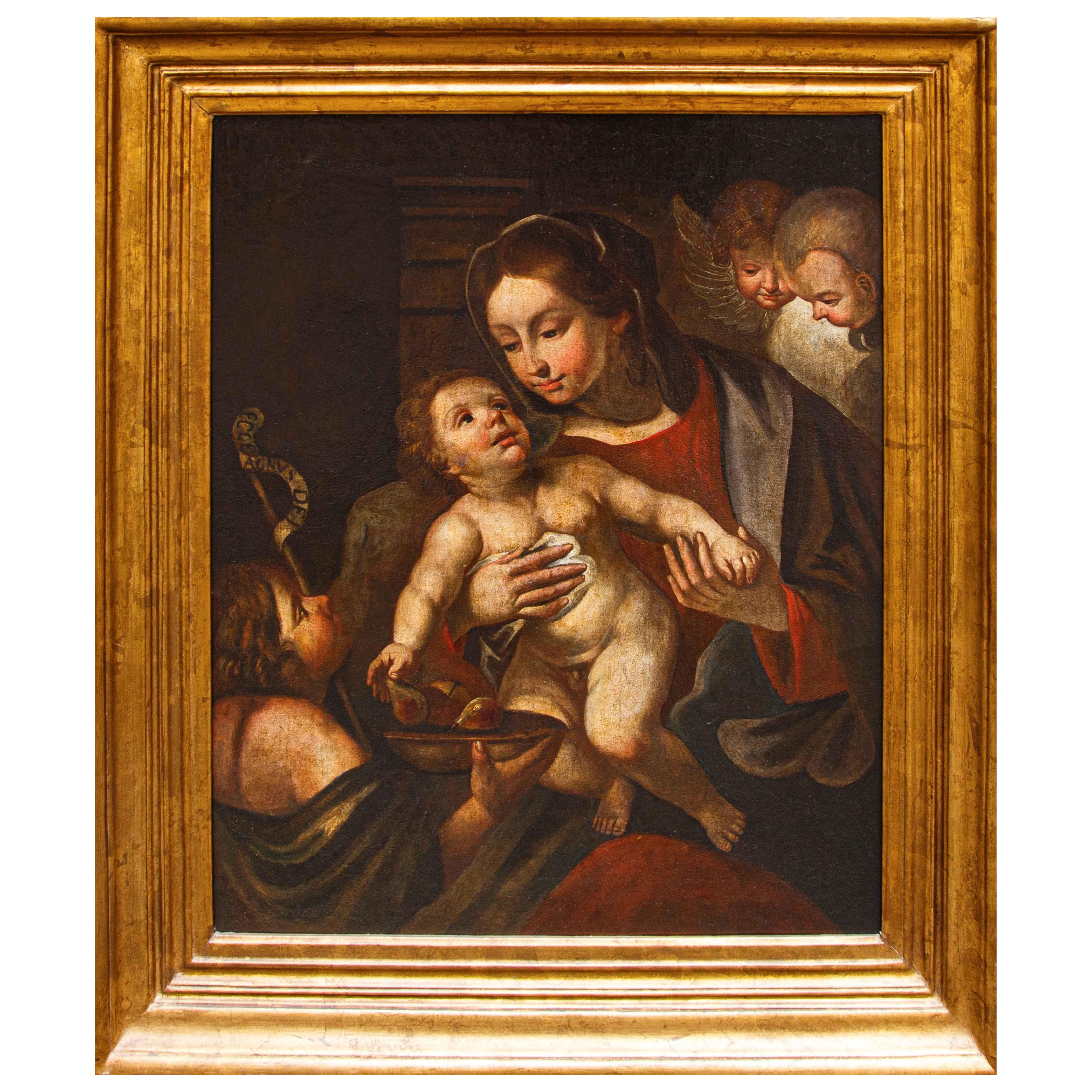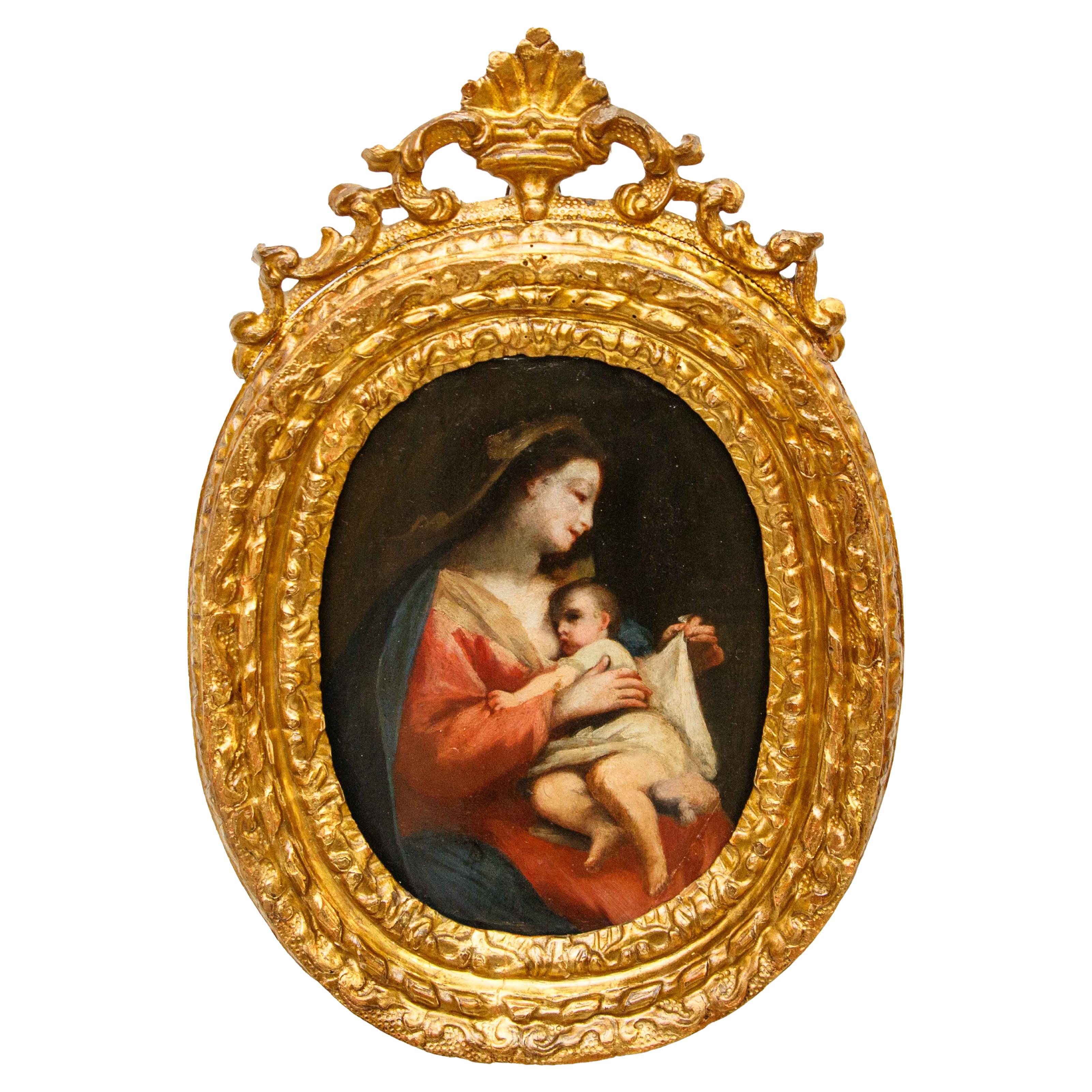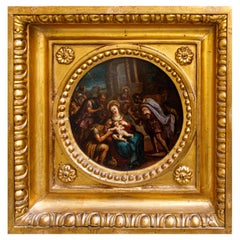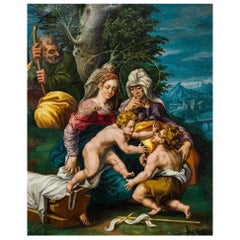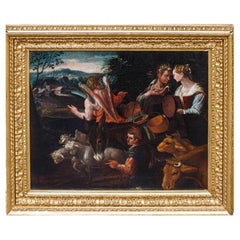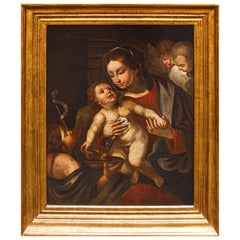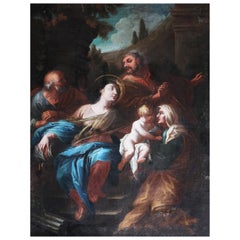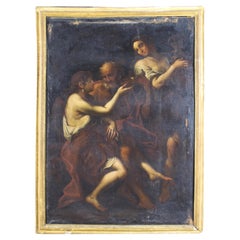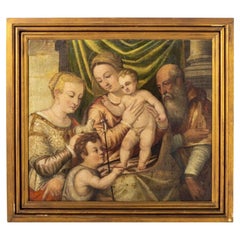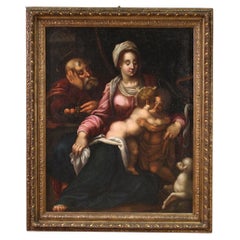Items Similar to 16th century, Tuscan school, Holy family with St. John
Want more images or videos?
Request additional images or videos from the seller
1 of 10
16th century, Tuscan school, Holy family with St. John
$10,633.07
£7,970.15
€9,000
CA$14,608.04
A$16,308.50
CHF 8,545.41
MX$199,632.02
NOK 108,526.76
SEK 102,326.96
DKK 68,511.28
About the Item
16th century, Tuscan school
Holy Family with St. John
Oil on panel, 82x71 cm
Framed, 92x81 cm
The term maniera, already in use in the Tuscan area in the 15th century, took on a special meaning in the Lives of Giorgio Vasari (who, moreover, was one of the principal mannerist painters): with the expression maniera moderna, the artist and art historian from Arezzo indicated the style of the great painters of that period, known to him as the Third Age, that is, what we now consider the mature Renaissance. It was therefore the style of artists such as Leonardo, Michelangelo, Raphael, and Giorgione. The term Mannerism arose in the 18th century to refer scornfully to all those artists who, beginning in the early decades of the 16th century, instead of imitating nature, took to imitating the "manner" of the great artists of the mature Renaissance. Today the term has been stripped of the negative connotation it originally had and indicates all those artistic processes that began to distance themselves from Renaissance modes in order to elaborate new and different patterns from those produced earlier, and that in some ways could even constitute an evolution of the Renaissance itself. Our panel presents all the key features of Mannerist painting. One of the most obvious aspects of Mannerist painting is that of the relentless pursuit of artifice and grace. Mannerist artists no longer aim for perfect mimesis of reality, but rather for a representation that enhances technical virtuosity and intellectual originality. The figures are often elongated, sinuous, with contorted and unnatural, almost dancing poses. This elongation of forms, evident in artists such as Parmigianino or Bronzino, gives the works a sense of almost ethereal elegance, but at the same time it alters classical proportion, introducing a feeling of artificiality. Another peculiarity of manner painting is the unconventional use of color and light. Colors in Mannerism are not always naturalistic; they are often acidic, iridescent, artificial, and are juxtaposed in surprising ways, creating striking visual effects. Light, in turn, does not illuminate scenes uniformly and rationally as in the Renaissance, but is often focused on specific points, creating dramatic chiaroscuro and highlighting unexpected details. This manipulation of color and light contributes to an often unrealistic, dreamlike or even hallucinatory atmosphere. Mannerist composition tends to be complex and asymmetrical, breaking with traditional Renaissance centrality and symmetry. Figures are often grouped in unusual ways, occupying corners or marginal portions of the canvas, leaving unexpected gaps in the center. Diagonal lines and serpentine compositions (such as the famous serpentine figure) lend dynamism and tension to the works, guiding the viewer's eye through nonlinear paths. This compositional approach reflects a willingness to experiment and a break with established rules.
In the painting in question, in the center of the scene, the Madonna is depicted with a pale, delicate complexion and her hair gathered by a light veil that encircles her head, creating an aura of purity. She wears a gown with pink sleeves that emerge from a wide yellow-gold mantle, with stiff, almost sculptural folds typical of the iconography of Tuscan art in the first half of the 16th century, which lend volume and a sense of solemnity to her figure. His gaze is turned toward St. John on the left. Baby Jesus is seated on the Virgin Mary's knees, in a pose that, while maintaining a certain childlike grace, already exhibits that twisting and fluidity typical of Mannerist figures. In his right hand he clutches an apple, a symbolic reminder of his sacrifice for the redemption of humanity. His expression is serene and contemplative as he interacts with little St. John with his left hand. St. John, on the left, wears a red cloth covering his lower body and a fur coat around one shoulder, a typical attribute of the Baptist. His pose is more dynamic than that of Baby Jesus, with his body leaning slightly forward, as if he were reaching out. He clutches a barbed cross, a symbol of his future martyrdom, and turns his gaze toward Jesus. On the right, in the background, appears St. Joseph. His face, framed by a thick white beard and hair of the same color, is characterized by deep, thoughtful expressions. He seems to watch the children carefully, with an expression of benevolent protection. He wears a suit in earthy tones, which complements him in the dark background. The background features a rocky landscape with dark tones, creating a stark contrast that makes the figures in the foreground stand out. On the left, a mountainous, almost Nordic landscape opens up, with stylized trees and a building emerging among the rocks, giving a feeling of depth and suggesting a broader, though not detailed, narrative context. The use of color is characteristic of Mannerism: tones are bright and sometimes acidic, especially in the Madonna's mantle and St. John's cloth, but juxtaposed with darker, earthier colors for the background and St. Joseph. The figures are elongated and sinuous, and the poses, while recognizable, tend toward a sophisticated and sometimes contrived elegance, breaking away from Renaissance naturalness.
- Dimensions:Height: 27.96 in (71 cm)Width: 34.26 in (87 cm)Depth: 1.97 in (5 cm)
- Style:Other (In the Style Of)
- Materials and Techniques:Wood,Oiled
- Place of Origin:
- Period:
- Date of Manufacture:16th Century
- Condition:Wear consistent with age and use.
- Seller Location:Milan, IT
- Reference Number:1stDibs: LU5918245995702
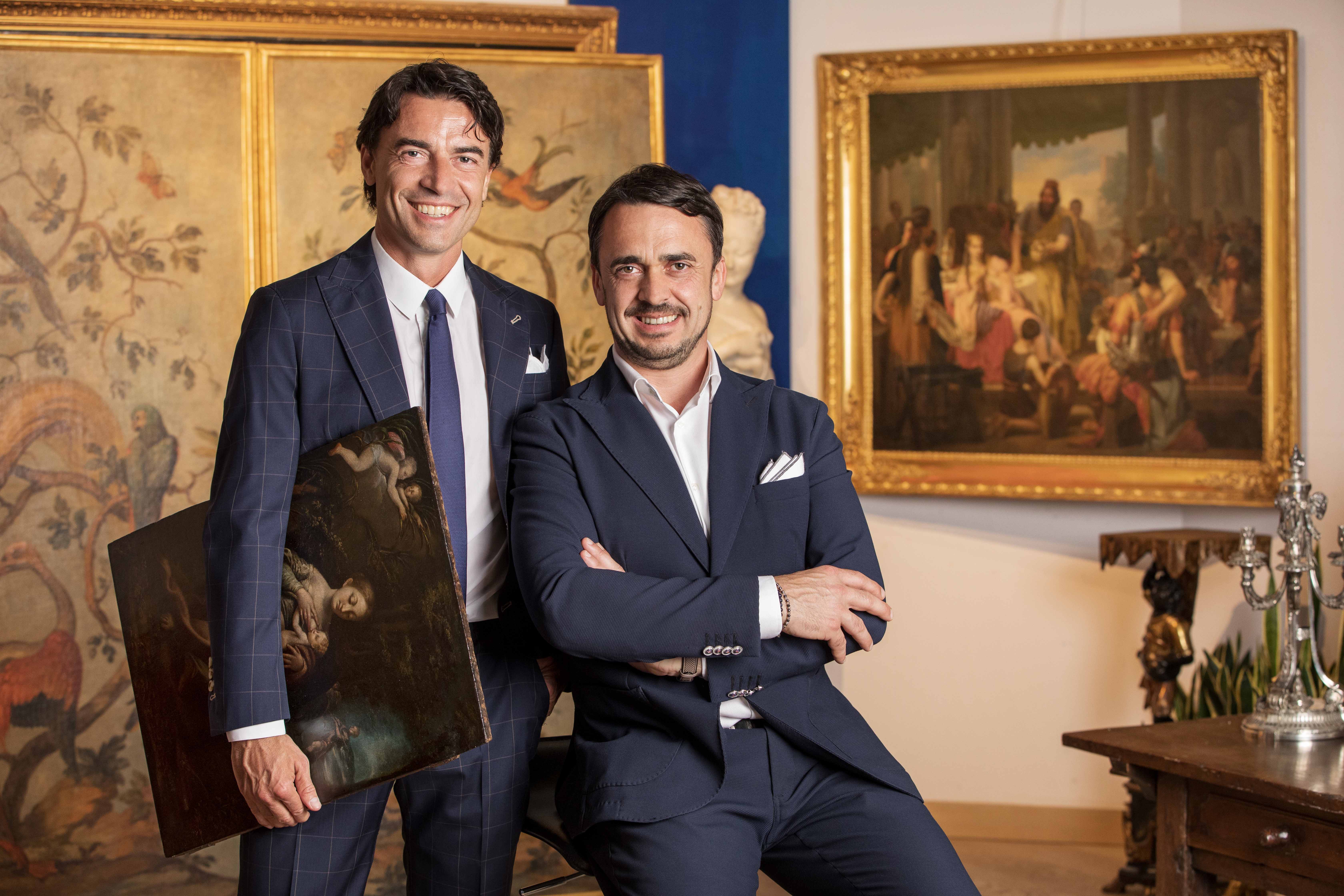
About the Seller
5.0
Vetted Professional Seller
Every seller passes strict standards for authenticity and reliability
Established in 2000
1stDibs seller since 2021
30 sales on 1stDibs
- ShippingRetrieving quote...Shipping from: Milan, Italy
- Return Policy
Authenticity Guarantee
In the unlikely event there’s an issue with an item’s authenticity, contact us within 1 year for a full refund. DetailsMoney-Back Guarantee
If your item is not as described, is damaged in transit, or does not arrive, contact us within 7 days for a full refund. Details24-Hour Cancellation
You have a 24-hour grace period in which to reconsider your purchase, with no questions asked.Vetted Professional Sellers
Our world-class sellers must adhere to strict standards for service and quality, maintaining the integrity of our listings.Price-Match Guarantee
If you find that a seller listed the same item for a lower price elsewhere, we’ll match it.Trusted Global Delivery
Our best-in-class carrier network provides specialized shipping options worldwide, including custom delivery.More From This Seller
View All17th century, Flemish School, Adoration of the Magi
Located in Milan, IT
17th century, Flemish School
Adoration of the Magi
Oil on copper, diam. 19.5 cm
Framed 35.3 x 35.3 cm
Engraved on the back in seventeenth-century calligraphy "Fiamingo"
Vivid wo...
Category
Antique 18th Century and Earlier Dutch Other Paintings
Materials
Copper
Mid-17th century, Rubensian School, Holy Family with St. John
Located in Milan, IT
Mid-17th century, Rubensian School
Holy Family with St. John and Elizabeth
Oil on copper, 36.3 x 29.5 cm
Framed, 47 x 38 cm
The glassy texture, glacial in the hardness of the sur...
Category
Antique 17th Century Belgian Other Paintings
Materials
Copper
Venetian school, Tobias and Sara in Nineveh, oil on canvas, 16th century
Located in Milan, IT
Venetian School, second half of the 16th century
Tobiah and Sarah led to Nineveh by the archangel Azariah
Oil on canvas, 48 x 56 cm - Framed, 58 x 72 cm
The present canvas, made w...
Category
Antique 16th Century Paintings
Materials
Canvas
Italian school, 17th century, Madonna and Child with St. John
Located in Milan, IT
Italian School, 17th century
Madonna and Child with St. John
Oil on canvas, 86 x 99 cm
Framed, 113 x 93 cm
The seventeenth-century painting presents the Virgin intent on presenti...
Category
Antique 18th Century and Earlier Italian Other Paintings
Materials
Canvas
Mantuan school, 18th century, Madonna suckling the Child
Located in Milan, IT
Mantuan school, 18th century
Madonna suckling the Child
Oil on panel, 27.5x22 cm
The softly collected and intimate dimension suggested by the present painting underscores the cert...
Category
Antique 18th Century and Earlier Italian Other Paintings
Materials
Wood
Roman school, 17th century, Madonna and Child
Located in Milan, IT
Roman School, 17th century
Madonna and Child
Oil on copper, 15 x 11 cm
Framed, 26 x 22 cm
The small copper on display here depicts the Madonna and Child against a dark background...
Category
Antique 17th Century Italian Other Paintings
Materials
Copper
You May Also Like
Italian School; Holy Family with St. Anne, 17th-18th century, oil on canvas
Located in Brescia, IT
Description
Holy Family with St. Anne
Oil on canvas
cm 75,5x57
In the center is clearly distinguished the Virgin Mary, seated with a halo, looking at the Child Jesus, who is held by...
Category
Antique Early 18th Century Italian Louis XIV Paintings
Materials
Canvas
Italian 13th century oil on canvas painting "Lot and Daughters"
Located in Cesena, FC
Lot and his daughters, EMILIAN SCHOOL
XVIIIth century
Oil on canvas 175 x 126 cm
Lot and his daughters is one of the themes most frequently encountered by seventeenth-century pain...
Category
Antique 18th Century Italian Baroque Paintings
Materials
Canvas, Paint
Flemish School 17th Century
Located in Madrid, ES
Flemish school 17th century
"Our Lady with the Child Jesus, St. John, St. Elizabeth and Zacarias".
Oil on canvas Relined.
Dimensions: 74 x 84 cm
good conditions.
Category
Antique 17th Century Dutch Baroque Paintings
Materials
Paint
16th Century Oil on Canvas Tuscan School Antique Religious Painting Holy Family
Located in Vicoforte, Piedmont
Great Italian painting from the second half of the 16th century. Oil on canvas painting depicting a Holy Family from the Tuscan school of remarkable pictorial quality. We find the typical stylistic features of the Renaissance with a wonderful pyramidal composition, a refined chromatic palette and particular attention to the drapery. In the center is the Madonna with the baby Jesus in her arms who reaches out toward Saint John the Baptist with a lamb at his side, a symbol of Christ's sacrifice. At the top left we see Saint Joseph sleeping...
Category
Antique 16th Century Italian Paintings
Materials
Canvas
Painting Holy Family with Saints 17th-18th century
Located in Milan, IT
Oil on Canvas.
The scene depicts the Holy Family accompanied by St. John and another saint kneeling before the infant Jesus, who is conversing with them while sitting on his mother's...
Category
Early 18th Century Other Art Style Figurative Paintings
Materials
Oil
Antique Nativity Italian Painting
Located in Alessandria, Piemonte
Antique Nativity Christmas Italian oil painting on canvas, from first half 17th century. Anonymous painter (as usual at that time) and with an authe...
Category
Antique Early 17th Century Italian Archaistic Paintings
Materials
Canvas
